

As time went on, the Pythagoreans made even more exciting Discoveries-and gave them strange cosmic meanings.
This curious blend was characteristic of Pythagorean geometry. For the initiates of the Brotherhood were seeking a special key to the universe in this wonderful new realm of numbers and abstract forms: triangles, circles, squares, spheres, and the more elaborate forms they made themselves.
And their search had a thrilling climax. After long and painstaking experiments, they discovered the five regular solids. These were remarkable and beautiful polyhedra, or shapes with many faces.
The full tale of these five solids can only be guessed at from
To impress this on newcomers, perhaps the first thing they were shown was how to make a mystic "pentagram," the emblem that members of the Order wore on their clothing. By means of a secret device (which we will explain later) a five-sided figure, or pentagon, was traced on cloth. Then its points were connected with diagonals to make a five-pointed star. Finally, around the five points of the star were placed the letters of the
Greek word for health, (hygeia), from which we get the word "hygiene."
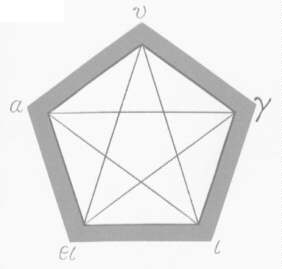
They made loose tiles of various shapes and placed them in
patterns on the ground. And they reached a striking conclusion. There were only three regular shapes of tiles that would fit together perfectly to cover a flat area completely: triangles (three sides), squares (four sides), hexagons (six sides).
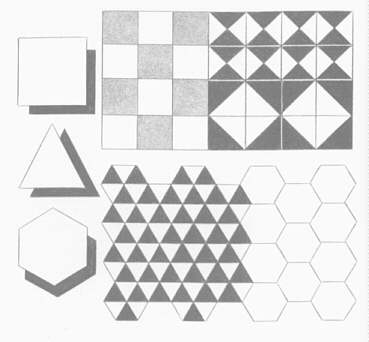
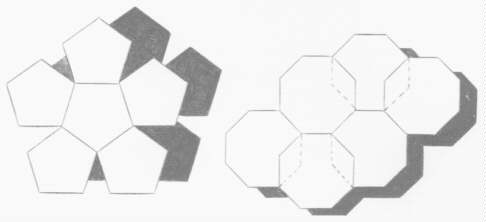
From this simple experiment came the fascinating idea of making "solid angles" by fastening tiles together with mortar, or gluing together shapes of wood, or sewing together pieces of leather. And this led to building shapes with the solid angles.
They called them regular solids because all the edges and faces and angles in each solid were equal. And after much experimenting, as we have said, they found five of these solids. The first two had been known from the most ancient times, but the next two were shapes that men had never seen before. As for the fifth, it was such a startling discovery that they thought they had upset the order of the universe!

The Cube. They mortared three square tiles into an angle, and fitted on three more tiles to form a cube with six square faces, which they called a hexahedron.

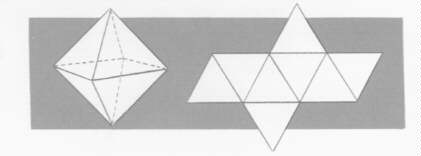
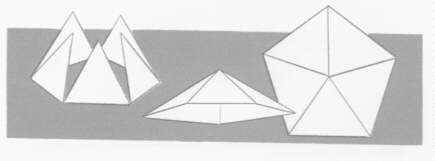
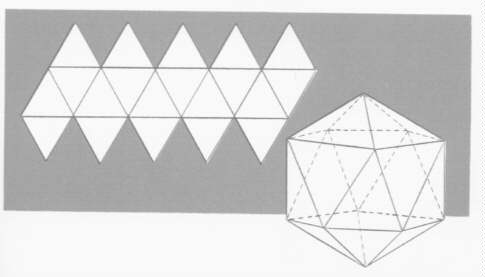
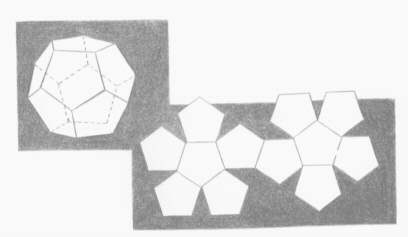
By that time the Secret Brotherhood had spread to many towns and islands of Sicily and southern Italy. The Sicilian members were friendly with another strange teacher who lived near Mount Etna, Empedocles, who dressed all in purple, gave away his money, and did scientific experiments Empedocles taught that the world was made of earth, air, fire, and water, and the first four regular solids came to be identified with these "elements. We know the identification from a famous passage in one of Plato's Dialogues, where it is made by a Pythagorean from Locri in time south of Italy. About the fifth solid, there were many weird stories. Its existence was kept secret as it seemed to require a fifth "element."
The esoteric reasoning g, as repeated later, went something like this:
"The cube, standing firmly on its base, corresponds to the stable earth. The octahedron, which rotates freely when held by its two opposite corners, corresponds to the mobile air.
"Since the regular pyramid has the smallest volume for its surface, and the almost spherical icosahedron the largest, and these are the qualities of dryness and wetness, the pyramid stands for fire amid the icosahedron for water."
As for the last-found regular solid, with its twelve faces, "Why not let the dodecahedron represent the whole universe, since the Zodiac has twelve signs!"
Such notions were typical of that age. And more than two thousand years later, the famous astronomer Kepler was still so awed by the unique properties of the five regular solids that he tried to apply them as planetary orbits: he assigned the cube to Sattmrn, the pyramid to Jupiter, the dodecahedron to Mars, the icosahedron to Venus, and the octahedron to Mercury, and he
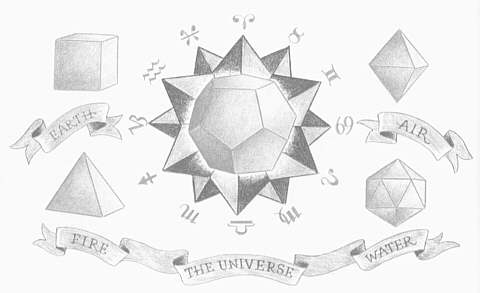
designed a machine to show this! Of course, the attempt was a failure.
Yet even today, these solids seem almost magical in their beauty and their interrelations.
In the first place, it is quite startling that there are only five. An infinite number of regular polygons can be inscribed in a circle-their sides becoming so small that they approach the form of the circle itself. But it is not so with regular convex polyhedra inscribed in a sphere. There are only these five possible shapes, and no others.
And these five shapes are connected with one another in a most remarkable way. All five can be fitted together, one inside the next, like the compartments of some magic box. And they are further linked by a strange inner harmony. They can be inscribed in themselves or each other, in certain endless rhythmic alternations. So it's no wonder the five regular solids were long referred to as the "dice of the gods."